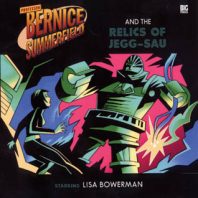
Released November 2004
Bernice Summerfield spent the course of her fourth series of adventures encountering famed foes from the televised Doctor Who universe and has begun her fifth series with exploits featuring the Grel and Galyari who both had their debuts off screen. For the third release, ‘The Relics of Jegg-Sau’ by Stephen Cole, its inspiration comes from the unlikeliest source within the Fourth Doctor era as Bernice confronts a derivation of the eponymous K1 from ‘Robot,’ the lonely creation comprised of living metal that was seemingly tailor-made for that singular tale and that was sadly destroyed at its end.
This robot hardly tops any lists of the most effective enemies even with its misguided notions, but it undoubtedly succeeds in anchoring an incredibly effective audio adventure given its very literal means of action and its imposing presence and power it possesses. Upon the failed colony world of Jegg-Sau with its exhausted soil and flimsy atmosphere that was allegedly funded by a stock of valuables stolen from Earth, Michael Kilgariff reprises his robotic role to excellent effect, and he helps to set the fairly grim tone of ‘The Relics of Jegg-Sau’ straight away as he interrogates Bernice and her story of accidentally being shot down and then finding herself stranded with two survivors at the colony site unfolds. The robot slowly grows more menacing as more information is slowly revealed and learned, and this gradual shift seamlessly intimates that something sinister is afoot and that an inherent danger lurks behind each word spoken and action taken.
Of course, the original robot was created to help do dangerous tasks in place of humans, and that continues to be the motivational or programmed decree here. However, the fact that that command has been taken to its logical extreme as living itself becomes the target for replacement is expertly revealed and fitting. This puts Bernice’s original thoughts about the mystery of the two Kalwells who have been stranded here for a year but who seem to be in no rush to leave into an entirely new light. Paul Shelley and Katherine Holme play this odd father-daughter pairing with the just the right amount of off-balanced emotion to make their strangeness nonetheless believable and engrossing. It makes the reveal that these two are artificial constructs of the robot all the more impressive, and the suggestion that Kalwell himself was a failed writer looking to profit off of his disgraced ancestor Kettlewell’s work by reinstating him into the legitimacy of scientific circles is nice bit of backstory that satisfyingly complements the realisation that there are corporations on Earth that have been trying to build these robots themselves despite the project being officially scrapped. Ironically, the robot and the others like it that it built on this planet are the treasures that Bernice came to look for, but their inability to understand just how they are meant to protect humanity and life makes them a practical failure in every sense despite the strong personification throughout.
Given the source material, the finale naturally includes an homage to the giant robot scene of ‘Robot,’ but the viewpoint is changed enough to make it wholly refreshing and completely engaging as Bernice desperately tries to call off a brutal attack from orbiting ships. Looking at a summary for this story, there’s almost no reason to think that it would amount to anything but another superficial dip into nostalgia; yet while it likely won’t be atop many lists as the most memorable story featuring Bernice, it unquestionably hits all of the right notes and uses its strong performances and slowly-evolving mystery on this barren world to become something surprisingly grim and utterly enjoyable.
- Release Date: 11/2004


Leave a Reply